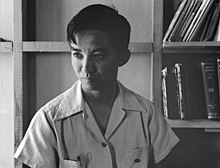Harvey Itano
Harvey Akio Itano (born November 3, 1920 in Sacramento, California - † May 8, 2010 in La Jolla ) was an American molecular biologist and pathologist and professor at the University of California, San Diego (UCSD).
Itano was an American of Japanese ethnicity. He studied chemistry at the University of California, Berkeley , where he received his bachelor's degree with top grades in 1942 (he was the best student, valedictorian , of his class). Then he was interned like most Americans with a Japanese background when the war with Japan broke out (in Tule Lake). Therefore, he could not attend the graduation ceremony in Berkeley, but received the University Medal from University President Robert Gordon Sproul during his internment. In July 1942 he was allowed to study medicine at St. Louis University with an MD in 1945. He then went to Caltech , where he received his doctorate in both physics and chemistry in 1950. At Caltech he was in Linus Pauling's laboratory . After receiving his doctorate, he became a senior assistant surgeon in the US Public Health Service and later head of chemical genetics in the Laboratory of Molecular Biology and Biology of the National Institute of Arthritis and Metabolic Diseases and medical director of the US Public Health Service (USPHS) in Bethesda (Maryland) , which he stayed until 1970. From 1970 until his retirement in 1988 he was Professor of Pathology at UCSD.
With Seymour Jonathan Singer and Pauling in Pauling's laboratory at Caltech in 1949, Itano found the cause of sickle cell anemia - an altered form of red blood cells - in a classic paper . For the first time, they attributed a disease directly to a change in a molecule. The difference of the hemoglobin of both red blood cells showed up in the gel electrophoresis (where Itano a modification of the original apparatus of Arne Tiselius used by Stanley M. Swingle) and Singer and colleagues suspected a change in the amino acid composition, by 1956 Vernon Ingram was confirmed . Itano also later dealt with genetic and blood diseases at UCSD, including continued sickle cell anemia.
In 1954 he received the Eli Lilly Award in Biological Chemistry and in 1972 the Martin Luther King Jr. Medical Achievement Award (for his work on sickle cell anemia, which affects mainly African Americans in the USA). In 1979 he became a member of the National Academy of Sciences (the first American of Japanese ethnicity) and he was a member of the American Academy of Arts and Sciences . The Japan American Citizenship League selected him as the Japanese American of the Biennium in the field of medicine.
literature
- Russell F. Doolittle: Harvey Itano (1920–1920), Biographical Memoirs National Academy 2014
Web links
- Obituary, ASBMB News 2011
Individual evidence
- ↑ D. Lowe, Das Chemiebuch, Librero 2017, p. 354
- ↑ L. Pauling, Harvey A. Itano, SJ Singer, Ibert C. Wells: Sickle Cell Anemia, a Molecular Disease, Science, Volume 110, 1949, pp. 543-548
| personal data | |
|---|---|
| SURNAME | Itano, Harvey |
| ALTERNATIVE NAMES | Itano, Harvey Akio (full name) |
| BRIEF DESCRIPTION | American biochemist and pathologist |
| DATE OF BIRTH | November 3, 1920 |
| PLACE OF BIRTH | Sacramento, California |
| DATE OF DEATH | May 8, 2010 |
| Place of death | La Jolla |
